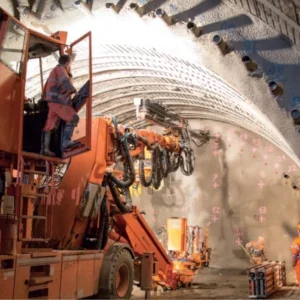The new EU directives and upcoming legislation decree that all the major existing road tunnels need to be upgraded to the latest safety requirements over the coming years. As a consequence, higher demands will be placed upon fire protection systems required to fulfil not only fire protection and fire life safety requirements but also provide the most economical and durable solution for the given risks in the tunnel.
Owners and designers must endeavour to choose the optimum solutions for the given circumstances. High durability concretes have become a prerequisite to increase the design life of structures. In order to achieve these high durability requirements, concrete is designed to have low permeability and hence poor performance in case of a fire with higher probability of spalling. This was evident in the dramatic Channel Tunnel fire in November 1996, which resulted in almost complete loss in concrete section.
There are many ways to protect a structure from the negative effects of heat, however thermal barriers emerge as themost robust and apropriate solution to protect against both the mechanism of spalling and that of strength loss caused by the exposure of concrete structures to elevated temperatures.
Fire damage
Over recent years, a number of notable tunnel fires in Europe (table 1) have led to the tragic loss in human life. In addition to this immensely ill-fated consequence, it is worth considering the structural damage that may occur following a fire in a tunnel environment, that can also cause, even if indirectly, severe danger to users.
Structural damage to tunnels implicates repair work at elevated costs as well as extended periods of loss in service. Mont Blanc, for example, cost the operator some €203M (US$304) in lost revenue and some €189M (US$284) in repairs.
Numerous bodies have begun to investigate tunnel user safety and methods of protecting the structure from fire. Active fire protection systems, which include water sprinklers, water mists and foam deluge systems, act directly on the fire and smoke element to reduce their effects before the situation escalates out of control. Passive fire protection systems, on the other hand, comprise all solutions aimed at protecting the tunnel structure from the fire.
When concrete tunnel linings are exposed to fire, the following structural issues need to be considered:
• concrete typically undergoes explosive spalling, and will continue to do so until there is no concrete left, or the fire diminishes;
• concrete loses structural strength at elevated temperatures; and
• steel reinforcement loses tensile strength at high temperatures.
The spalling phenomenon causes the violent detachment of fragments of the structure with consequent reduction in section of thelining and thus reduction in resistance and structural capacity.
The second phenomenon is the loss in structural strength of concrete and reinforcement steel at high temperatures, also illustrated in Figure 2 (adapted from ITA 2004 & Khoury 2005).
As can be seen in Figure 2 maintaining the structural concrete below 300°C (i.e. limiting the maximum temperature in the structure) in the event of hydrocarbon or cellulose fires prevents all negative structural issues from occurring.
In additional to the maximum temperature criteria, the rate of heating is crucial as it has a dramatic effect on the spalling mechanism: the higher the heat release rate (HRR), the higher the generation of water vapour pressure and the thermal expansion of the aggregates. This thermal shock can cause quite spectacular explosive events.
The role of passive fire protection is to protect the structure from these consequences.
Fire load and curves
The event of a fire has very different effects on road/rail tunnels when compared to civil works due to the highly combustible loads entering tunnels, such as Heavy Good Vehicles (HGVs) and freight trains, which can cause a severe fire in case of an accident, meaning a higher fire load, higher maximum temperatures and a faster heating rate.
Some design fire curves used until recently underestimated the real HRR and maximum temperature during fires. During recent real life fires, fire loads greater than 200MW and gas temperatures above 1350°C were registered. As a result of these fires, tests were conducted, guidelines and directives published giving criteria which designers can use for the fire protection of new build or existing tunnels.
UPTUN WG2, for example, recommends that the ISO834 be used if there are no (or only empty) HGVs passing through the tunnel. The maximum HRR can be estimated between 5 and 50MW. In case of HGVs the fire loads can be much higher and will generate a HRR of between 50 and 250MW, depending on the amount of combustible materials it contains thus the HC or the RWS curve is recommended (see Table 2).
The structural response to a tunnel fire depends upon the nature of the fire which can vary considerably from fire to fire. The key feature is the temperature-time curve imposed by the fire at the structure’s surface, and especially:
• The heating rate (i.e. the rate of temperature increase) which influences the development of temperature, moisture and pore pressure gradients within the concrete;
• The maximum temperature level which influences the nature of the physiochemical relations in the material and through this its properties;
• The duration of the fire which influences the temperature development into the structure with time; and
• The cooling regime (eg water cooling would have a different influence upon the material and the temperature distribution from “natural” cooling).
To establish the characteristics of the fire protection to apply to a structure, it is necessary to predict foremost the type of fire to which the structure might be subjected. Numerous fire curves (see Figure 3) exist that simulate, theoretically, the increase in temperature with time, given a fire load.
Assessment methods are constantly being developed to demonstrate the ability of materials and fire protection systems to prevent concrete spalling and steel and metal elements from heating and melting due to rapid heating under fire exposure conditions and to mitigate both structural and economic consequences of fire.
Fire curves used include:
ISO 834 (celluloid) curve: this curve is utilised in the case of fires in buildings (schools, offices, hospitals, hotels, etc.) and simulates a celluloid fire in an environment with adequate ventilation.
Hydrocarbon curve (HC): this curve is applicable in the case of a small size fire, of petrol or combustible liquid, such as a car tank or a gasoline cistern.
Hydrocarbon modified curve (HCM): represents a compromise between the traditional hydrocarbon curve (liquid or gaseous) and real life situation that can take place inside a tunnel. It is more severe respect to the hydrocarbon curve.
RWS (and UNI 11076): This curve is widely recognised throughout Europe as one of the most representative of a tunnel fire.
Many tests have been carried out both real scale – inside disused tunnels – and in laboratories to understand the evolution of fires inside tunnels. It was possible to note that the registered temperatures during a fire are higher than those of a similar fire load in open air or inside a building. Almost all countries that utilise the RWS curve, have decided to limit the thermal programme to two hours, as it is presumed that after this time, rescue services will be able to get close to the source of the fire and begin the fire suppression. Recent large scale fires, particularly that inside the Mont Blanc, have demonstrated that the temperatures inside the tunnel are too high to consent an intervention even after many hours and therefore some countries (Austria and Switzerland) have extended the RWS curve to 180 minutes (3 hours).
Polypropylene fibre modified concrete
In recent years, fibre manufacturers have promoted multi- and monofilament polypropylene fibres (32 to 18 micron diameter fibres – Figure 4) to contractors and design teams, detailing that the addition of 1 to 3kg of fibres added to the concrete mix gives an extremely economical solution to concrete “fire protection”.
From testing, fibre modified concrete will exhibit less spalling, and in some cases no spalling whatsoever. One theory is that the melting of fibres at approximately 160°C produces channels for escape of the steam that allows water vapour inherent in the concrete matrix to escape without generating internal pressure, thus inducing high permeability at the critical time required and thereby preventing explosive spalling. Another theory claims that micro cracking around the fibres contributes to steam reduction.
For specific design fires, the quantity of fibres required will alter accordingly – then larger the design fire, then greater the quantity of fibres required. As an example, for an ISO834 cellulose design fire, approximately 1kg/m3 of fibres are required, whereas for RWS hydrocarbon design fires, the quantity may increase to approximately 3kg/m3 as indicated. Concrete mixes with high fibre contents tend to be difficult to pump and place, and careful mix designs using admixture technology to overcome these problems are required.
Although the fibres offer an anti-spalling system, they do not protect the structural concrete from the detrimental effects of high temperature nor do they protect any structural reinforcement at the heat exposed concrete tunnel lining. Consequently, the use of fibre modified concrete should be considered carefully for use in structurally reinforced concrete tunnel linings.
Thermal barriers
Thermal barriers are designed to be installed (spray applied, cast Insitu or even as prefabricated boards) as a shield to protect the structure from fire at any time.
Thermal barriers typically consist of extremely porous, low density concretes and also contain polypropelene fibres. They are not only used to prevent the spalling of concrete, but also to protect the concrete and the steel reinforcement from the damaging effect of heat on the resistance of such materials.
Historically these have been vermiculite cement based products applied by hand spraying with the technology being transferred to tunnel applications from the petrochemical industry.
Vermiculite based systems are relatively weak products (2.5MPa compressive strength) and may not offer adequate mechanical properties in the light of increasing client demands for more durable solutions where cyclic loading resistance is required. Vermiculite systems need to be mechanically bonded to the tunnel structure with stainless steel mesh. It is vital for sprayed systems to have adequate durability to resist both physical and chemical attack during the normal service life of the tunnel.
New studies have permitted the development of thermal barriers that do not contain vermiculite and that can be installed, as a fully bonded system, directly onto the substrate without the necessity of mechanical fixing, such as a mesh, or as a mechanically bonded system, in high risk areas or where surface preparation is not possible, or as a combination of the two.
New high durability mortars have recently been developed which exhibit increased fire protection and structural properties allowing a thin and impact resistant solution for fire protection. These products are based on light weight concrete technology giving compressive strength of up to 15 MPa.
Application thicknesses are designed as a function of the fire curve, exposed time of the structure to the fire, and the interface temperature (i.e. temperature that the concrete can reach in that time) and of the cover (distance of the reinforcing steel from the interface). Typical thicknesses can range from 30 to 50mm.
This barrier thickness ensures that in the case of a fire the total integrity of the support avoiding that it may spall or reduce the structure’s capacity. Following a fire event, it will not be necessary to repair the concrete structure as it will remain integral.
In the particular circumstance where anchorage system for ventilation of cladding are supported on the structural lining, they would not come away because spalling would not take place.
This fire protection mortar may be:
• sprayed as sprayed concrete, manually or via mechanized robotic application, with or without the necessity of mechanical fixings due to its high adhesive tensile strength property (1-1.5 N/mm2 to concrete)
• cast insitu
• precast in panels
In the first instance, an alkali-free accelerator will be added to the wet mix to ensure rapid hardening and thus achieve rapid bond strength. To avoid using mechanical anchorage systems, it is necessary to prepare the substrate onto which the mortar will be sprayed to ensure sufficient roughness necessary for bonding. This effect may be obtained in many ways: through hydro milling of the substrate, in order to expose the aggregate, in the case of existing structures with smooth surfaces, or through jet washing of the concrete with a prior treatment of the surface with a bond inhibitor. In practice, before casting the lining, the formwork is treated with products that inhibit the superficial bond of the cement paste so that , following demoulding, high pressure washing will expose the aggregates making the surface appropriate for a fully bonded solution.
The level of necessary roughness, for a safe and complete adherance of the mortar can be easily measured via laser equipment (see Figure 5) connected to a computer.
The laser gun is placed on the prepared surface and, via a calculating system, provides 3 index numbers: Rp, Z2 and Ia. The level of roughness is acceptable when these indexes reach the minimum values as reported in Table 4.
The mortar, if applied as a fully bonded sprayed thermal barrier, ensures continuity in the concrete structure.
This means that possible cracks that may occur in the open structure will be visible on the mortar without however compromising the fire protection, allowing inspection of the structure below. (This would not be possible with a mechanically fixed solution or the board solution).
The main disadvantage with sprayed systems is the resultant sprayed surface finish, as some clients require a high level of reflectance, particularly for highly trafficked road tunnels. Float finishing and over painting is possible, but labour intensive. Rail tunnel surface finish requirements are less onerous in general, and an “as sprayed” finish is acceptable, making the use of sprayed fire protection mortars particularly viable.
The mechanically fixed spray applied and the pre-fabricated board solutions permit protection of the structure without the necessity of hydro milling the existing structure (substrate).
Taylor-made pre-fabricated boards, with design thickness and curvature according to individual project requirements, have an excellent surface finish and are fixed to the structure via stainless steel fixing bolts. The installation method requires more time than a fully bonded sprayed solution.
Pre-fabricated fire protection boards offer a clear advantage for box shaped tunnels where there are no curved tunnel walls or complex geometries e.g. cut and cover and immersed tube tunnels. Furthermore, the surface finish of the board systems is appealing to clients. However, they are not well suited to curved profile tunnels and are generally 1.5 to 2 times more expensive than sprayed systems, which can prove cost prohibitive. Apart from their high cost, vehicle collision damage is often considered a maintenance problem in road tunnels using pre-fabricated board protection systems.
The MEYCO Fire Protection System, MEYCO Fire shield 1350, has recently been applied inside the Bodio section of the Gotthard Base Tunnel (see Feature on page 30).
Conclusion
The amount of European transport tunnels in daily use without any form of fire protection is of concern. Of course, following risk assessments a great majority of these tunnels may not need fire protection, but certainly under the new requirements of the European Directive No.2004/54, and perceived new directives there are many tunnels that will require retrofit fire protection systems to be installed.
Very thin spray applied thermal barriers (less than 45mm) will be required for many of these tunnels if clashes with the operational envelopes are to be prevented. The use of polypropylene fibre modified concrete is not considered an option for many existing tunnels due to the limited operating space. However, consideration may be given to sprayed concrete with polypropylene fibres if the space profile permits a minimum layer thickness of approximately 80mm.
It should also be noted that the general trend in increasing vehicle and train sizes and also increasing the tolerance to the structural lining to avoid clashes (at higher line speeds for example) puts additional pressure on the industry to develop very thin fire protection solutions.
In order to determine which system is appropriate for specific tunnels, consideration of the risk of structural collapse of the tunnel linings, and the effect it will have on 3rd parties is required.
In the case of existing tunnels, passive fire protection, in the form of thermal barriers, applied to the existing structure seems to be the only solution.
A final consideration stems from the fact that nowadays all structures, for durability reasons, will need to be designed with concrete that has lower water/cement ratios (therefore very low porosity).
This, from the fire behavioural side, does not represent a good solution because the structure is very dense and compact and therefore, does not permit the water vapour to release the pressure. In this case, to ensure the durability of the structure from all points, (chemical and thermal attacks), it is necessary to utilize a concrete with low w/c ratio and a thermal barrier.
An example of this application can be found in TBM tunnels: the precasted segmental lining have high densities and therefore low permeability, therefore are very vulnerable to spalling.
Fig 1 – Concrete panels showing the spalling mechanism Fig 2 – Loss of resistance and structural capacity Fig 3 – Design fire curves Fig 4 – Polypropylene fibres Fig 5 – Roughness measured with a laser






